-
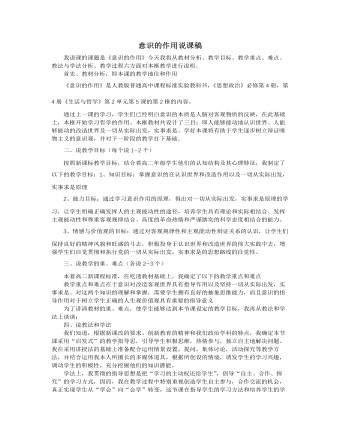
人教版高中政治必修4意识的作用说课稿(一)
1、课题引入:我设计以提问哲学到底是什么?的问题激发学生的阅读兴趣。我设计典型事例,通过学生讨论,教师总结的形式,并得出其实哲学就在我们身边。2、讲授新课:(35分钟)通过教材第一目的讲解,让学生明白,生活和学习中有许多蕴涵哲学道理的故事,表明哲学并不神秘总结并过渡:生活也离不开哲学,哲学可以是我正确看待自然、人生、和社会的发展,从而指导人们正确的认识和改造世界。整个过程将伴随着多媒体影像资料和生生对话讨论以提高学生的积极性。3、课堂反馈,知识迁移。最后对本科课进行小结,巩固重点难点,将本课的哲学知识迁移到与生活相关的例子,实现对知识的升华以及学生的再次创新;可使学生更深刻地理解重点和难点,为下一框学习做好准备。

人教版高中英语必修1Journey Down the Mekong说课稿
2. let the Ss complete the forms paragraph by paragraph. Purpose here is to help Ss to get the habit of reading a passage as a whole, and pay attention to the organization of the text, as a result the Ss will fully understand the whole passage.3. ask Ss to retell the passage with the help of the key words in the form.Since the Ss in the class are in different levels, so I let them to fill in the blank to understand the meaning of the words and phrases better. ( That’s all for the while-reading. Now let’s move to the fifth step.)Step V: Post-reading (10mins) ---DiscussionIn this part students are asked to discuss in groups and list Wang Kun’s and Wang Wei’s attitudes about the trip. After that, Ss are encouraged to express their attitudes with the whole class. Collect their answers and don’t forget to praise them even if their answers may not be perfect.In this activity, discussion provides a vivid and active learning environment for Ss to communicate in English with newly learned language items. (Finally it comes to the homework.)StepⅥ: Homework (1min)1. Ss are required to read the text again after class and figure out the meaning of some complex sentences.2. Do the exercises on P19; This can help Ss to consolidate what they’ve learnt and make preparation for the next lessonPart4. Blackboard design.(说板书设计)On the top, there is the title of this lesson. On the left, there are main ideas for each paragraph. On the right, there are some new words and expressions.Unit 3 Travel journalJourney down the MekongMain idea of each para.:Para1: deciding to take a great bike trip along the Mekong river.Para2: Different attitudes between Wang kun and Wang wei.

人教版高中英语必修1English around the world说课稿
(3)v. 给:提出;展现,显现present sb. with sth. ; present sth. to sb. 把. . 交给;颁发;授予present sth. (for sth. )/present sth. to sb. e. g. Om his birthday, his friends presented him a collection of stamps. 在他生日时,他的朋友们送给他一套邮票作为礼物。The sword was presented by the family to the museum. 这家人把宝剑捐赠给了博物馆。The committee will present the final report to Parliament in June. 委员会将在六月向议会提交最后的报告。You need to present yourself better. 你需要更善于展现自己。It is essential that we present a united front. 至关重要的是我们要表现得更加团结。Step 4 ConsolidationT:Now that we have got a general idea of these words and phrases. Lets make up some sentences using them to master them. Suggested sentences:1. Your duties include typing letters and answering the telephone. 2. It is one of the greatest roles that she has played. 3. A large number of people have applied for the job. 4. The number of the panda is declining. 5. I'11 go there, even if I have to walk. 6. He came up to me to ask for a light. 7. The novel is about a family who can't communicate with each other. 8. He based his plan on interests of most people. 9. Why doesn't he make use of his singing talent?Step 5 Summary and homeworkT:Today we dealt with several new words and phrases. After class I hope that youcan read them again and again to keep them in mind. That's all for today. You aredismissed.

人教版高中英语必修2Cultural Relics说课稿2篇
Ⅲ. Analysis of the teaching material:The topic of this unit is cultural relics. Students are quite interested in topics about different cultures around the world. This is the second period of the whole unit. As a reading class, the passage mainly talks about the history of the amber room (how it was made, sent as a gift, lost and rebuilt).According to the new national curriculum, when teaching reading, much emphasis should be put on training the students’ reading skills.Ⅳ. Teaching objectives1. Language objectives:1) Students are required to master the key words and phrases occurred in the passage (e.g. amazing, decorate, belong, in return, less than etc.)2) Students are required to learn the attributive clause and acquire the sentence pattern.2. 1) Students are required to describe a certain thing by using the new sentence patterns.2) Students are required to master two kinds of reading skills—skimming and scanning, and learn to use them in their daily reading.3. 1) Students are required to know the history of the amber room.2) Students are required to appreciate cultural relics and understand the importance of protecting them.Ⅴ. Teaching important and difficult points1) the new words, phrases, and sentence pattern in the course of reading.2) Teaching difficult point: Help the students master two kinds of reading skills—skimmingand scanning and learn to apply them in daily use.Ⅵ. Teaching methods:Task-based method & Top-down model Ⅶ. Teaching aids: PPT, pictures, blackboard Ⅷ. Teaching procedure:

人教版高中英语必修3Canada-the true north说课稿4篇
Good afternoon, teachers, It’s my great pleasure to be here sharing my lesson with you.The content of my lesson is Senior English Book 3 Unit 5 Canada —— “The true North”.I’ll be ready to begin this lesson from five parts. Analysis of the teaching material,the teaching methods,the studying methods, the teaching procedure,and Blackboard design.First, let me talk about the teaching material.Part 1 Teaching Material:This unit is about the introduction of Canada. By studying of this unit,we’ll enable the students to learn the geography, population, main cities, and natural beauty, natural resources of Canada. Through the training of the unit, it also requires students to learn some Language skills such as the expressions of position and emotions.So it plays an important part in the English teaching in this book.After studying the teaching material and analyzing the rule of children’s growing of mind,I think the teaching aims are the followings:1.Knowledge objects:(1) make the students learn some new words and phrases(2) make the students understand the content of the lesson.2.Ability objects:(1)To develop the Ss’ abilities of listening, speaking, reading and writing. Especially reading and speaking ability.(2) learn to talk about the characters of Canada in English(3)To train the Ss’ ability of working in pairs.3.Emotion objects:(1)Enable students to understand the characters of Canada..(2)Stimulate Ss to work hard to make China stronger.Part 2 Teaching Methods:I think helping students learn to master new words and phrases and improve the students’ reading and speaking ability is import and the difficult.According to the analysis of the teaching material and the import points and the difficult points,I will use the following teaching methods : question-guiding approach; fast-reading and careful reading; multi-media teaching methods; discussion

人教版高中英语必修4Working The Land说课稿3篇
Knowledge objectives:(1) to make Ss grasp the usage of words, expressions and sentence structures: statistics, struggle, thanks to, rid of, some patterns for persuasion, the “ing” form as subject and object;(2)to use learnt knowledge to persuade sb.Ability objectives:(1) to develop Ss’ reading skills(skimming, scanning, word guessing);(2) to improve Ss’ speaking, communicating and cooperating skills.Emotional objectives:to make Ss know the contribution of Yuan,and learn his spirit and his simple life time.Teaching important and difficult points:(1) some words, expressions and sentence structures mentioned above;(2)the content of the text;(3)training their reading and speaking skills.Teaching methods: CLT, TBLT,QT.Learning strategies: CLS, QLS, TBLS.Teaching procedures:Step 1 lead-in: (1) teacher plays a piece of recent news from CCTV about the harvest of the super hybrid rice, and ask students whether they know Yuan or not, and talk about him and his contribution.(2)Brain storm: let Ss describe Yuan in their minds including his appearance, his living condition and so on.Step 2 fast reading tasks:(1)teacher introduces Yuan and super hybrid rice(2)make Ss read the text as fast as possible with questions. Such as: what’s the general ideaof this passage? What’s Yuan’ dream? (skimming and scanning skill)Step 3 intensive reading tasks(1)let Ss read the text silently, find topic sentence of each paragraph and draw the difficult sentences and the knowledge what they don’t understand.(words guessing)(2)teacher and Ss talk about the important words, expressions and sentences together, and ask Ss to retell the content of the text.(summarizing and paraphrasing)(3)teacher summarize this part.(4) read again following the courseware.

人教版高中英语必修5Making the news说课稿4篇
今天我们来介绍一下必修五第四单元的授课方式。这个单元的题目是Making the news。应该是学生比较感兴趣的话题,学生往往对新闻工作充满好奇,所以我们可以利用这个机会多设计一些师生互动和学生互动,来激发起学习的积极性,提高学习效率。同时我们可以利用这个单元不仅帮助学生掌握语言知识,培养语言能力,同时让其了解新闻工作的重要性,培养起社会智能感。这个单元分为六个课时,它的教学目标是这样的:语言目标是掌握词汇表中的常用单词和短语,掌握倒装句的一些基本用法。 技能目标是能初步掌握约会的基本句型并在真实的场景下正确运用。新闻报道类文章的写作技能。采访的基本规范和沟通技能。情感目标是对新闻报道的客观性和真实性有更好的理解。对新闻记者的职业有更深入的了解,并能体会其工作的重要性。下面我们来介绍一下第一课时的授课方式,第一课的教学目标是这样的第一课时的教学目标语言目标:单词:Occupation, journalist, editor, photographer, curious, personality, enthusiasm
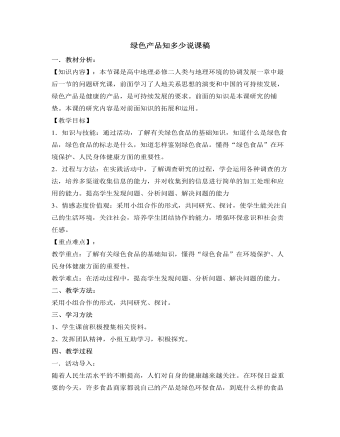
人教版高中地理必修2绿色产品知多少说课稿
各小组派代表汇报。4、教师提出问题组织学生讨论:⑴要想了解更多的绿色食品,了解绿色食品的销售情况,我们应该怎么做?⑵要想了解广大消费者对绿色食品的态度,食用绿色食品的意义,是否懂得辨认绿色食品,以及什么样的人群对此知识最缺乏等,我们应该怎么做?组织学生汇报交流。5、做个“绿色食品”广告设计师。为你喜欢的绿色食品设计广告语,每组推荐一个。6、让学生了解绿色食品认证程序。7、绿色食品打“假”队员在行动。8、向学生介绍生态绿色食品基地。三、活动总结:通过研究、探讨,了解学生对绿色食品的态度。提问:民以食为天,吃,是一个大问题,如果你的爸爸妈妈让你到超市买牛奶、方便面等,你会选择什么样的食品?为什么?希望通过今天的学习,同学们能够做到绿色消费,也希望你们向自己的家人、向周围的了解学生对“无公害食品”、“有机食品”与“绿色食品”的认识。
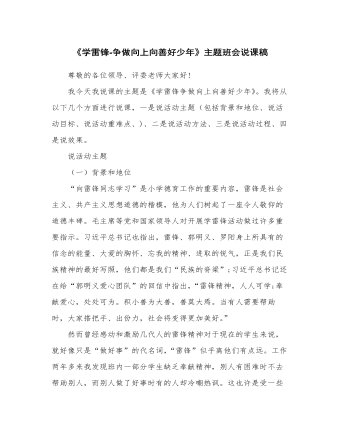
《学雷锋-争做向上向善好少年》主题班会说课稿
活动三——读《雷锋日记》让学生读雷锋给一位陌生老人送完手套后写的日记。重点理解“一路上,我的手虽冻得像针扎一样,心中却有一种说不出的愉快。”这一句话。让学生谈谈自己的感受。(此活动的目的是让学生了解雷锋的内心世界,理解雷锋精神的实质,全心合意为人民服务。)(三)讨论交流新时代还需要不需要学习雷锋?(1)小组讨论雷锋精神是不是已经过时了?新时代还用学雷锋吗?通过小组的讨论让学生认识雷锋精神的重要性,这是本次班会的重点内容,要引导学生积极参与,达到真正的思想教育。通过辩论后利用课件为学生们出示新时代的雷锋,《小林浩救人事迹》、感受社会的正能量。(设计本活动是让学生在讨论和辩论引起学生思想和情感的升华,更加深入理解雷锋精神对社会的重要性。)
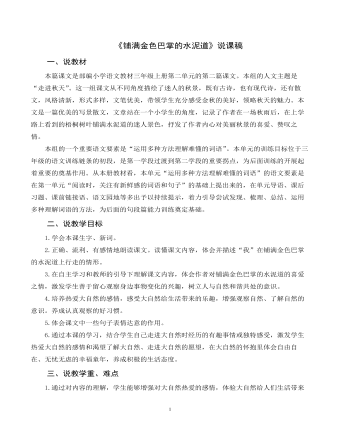
《铺满金色巴掌的水泥道》说课稿
语文学习教无定法,重在得法,贵在用法,施教之功,贵在导学,因此,语文学习不仅要帮助学生学习和掌握知识,更重要的是让学生学会求知,让学生学会学习方法,变“我学会”为“我会学”。结合本课语言优美,情境奇特的特点,我引导学生用“自读自悟、美读交流、入境体验,升华情感”等学习方法来理解课文内容,感悟文章意境之美,体验探究自然之乐。
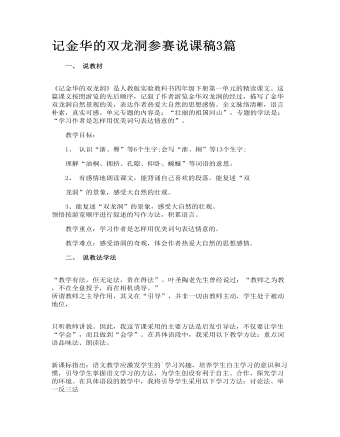
记金华的双龙洞参赛说课稿3篇
1、 认识“浙、臀”等6个生字;会写“浙、桐”等13个生字; 理解“油桐、拥挤、孔隙、仰卧、蜿蜒”等词语的意思。 2、 有感情地朗读课文,能背诵自己喜欢的段落。能复述“双 龙洞”的景象,感受大自然的壮观。 3、能复述“双龙洞”的景象,感受大自然的壮观。 领悟按游览顺序进行叙述的写作方法,积累语言。 教学重点:学习作者是怎样用优美词句表达情意的。 教学难点:感受溶洞的奇观,体会作者热爱大自然的思想感情。
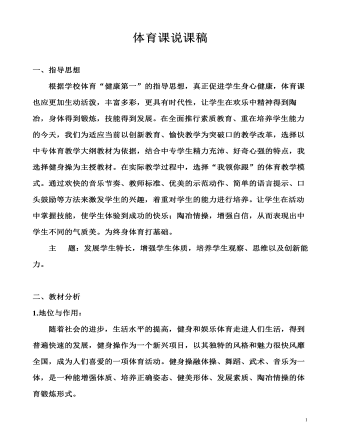
体育说课课稿
二、教材分析1.地位与作用:随着社会的进步,生活水平的提高,健身和娱乐体育走进人们生活,得到普遍快速的发展,健身操作为一个新兴项目,以其独特的风格和魅力很快风靡全国,成为人们喜爱的一项体育活动。健身操融体操、舞蹈、武术、音乐为一体,是一种能增强体质、培养正确姿态、健美形体、发展素质、陶冶情操的体育锻炼形式。
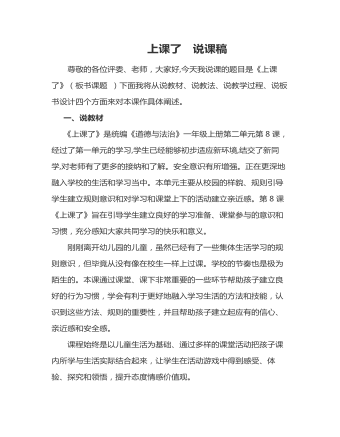
上课了 说课稿
《上课了》是统编《道德与法治》一年级上册第二单元第8课,经过了第一单元的学习,学生已经能够初步适应新环境,结交了新同学,对老师有了更多的接纳和了解。安全意识有所增强。正在更深地融入学校的生活和学习当中。本单元主要从校园的样貌、规则引导学生建立规则意识和对学习和课堂上下的活动建立亲近感。第8课《上课了》旨在引导学生建立良好的学习准备、课堂参与的意识和习惯,充分感知大家共同学习的快乐和意义。刚刚离开幼儿园的儿童,虽然已经有了一些集体生活学习的规则意识,但毕竟从没有像在校生一样上过课。学校的节奏也是极为陌生的。本课通过课堂、课下非常重要的一些环节帮助孩子建立良好的行为习惯,学会有利于更好地融入学习生活的方法和技能,认识到这些方法、规则的重要性,并且帮助孩子建立起应有的信心、亲近感和安全感。课程始终是以儿童生活为基础、通过多样的课堂活动把孩子课内所学与生活实际结合起来,让学生在活动游戏中得到感受、体验、探究和领悟,提升态度情感价值观。
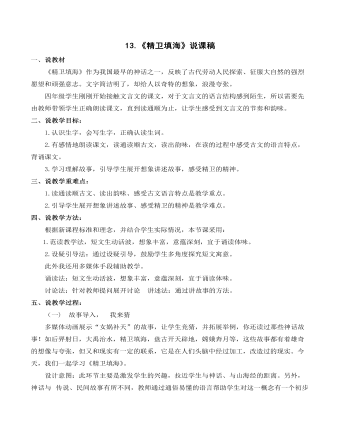
《精卫填海》说课稿
1.教师范读全文,?学生听记生字读音和句中停顿。学生初次接触文言文,在朗读上有困难。教师应通过各种方式,帮助学生把课文读正确、读通顺。其中,教师的范读、引读尤为重要。?2.学生自由朗读,力求达到正确,流利,有感情的标准,然后以同桌竟读来检验读的效果。3.师生评判,师生齐读。? 4.教师指导学生借助所学知识,课文注释和工具书,疏通文意。帮助学生疏通文意,我准备采取三种方法:
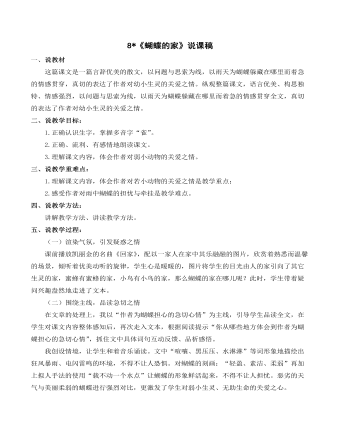
《蝴蝶的家》说课稿
课前播放凯丽金的名曲《回家》,配以一家人在家中其乐融融的图片,欣赏着熟悉而温馨的场景,倾听着优美动听的旋律,学生心是暖暖的,图片将学生的目光由人的家引向了其它生灵的家,蜜蜂有蜜蜂的家,小鸟有小鸟的家,那么蝴蝶的家在哪儿呢?此时,学生带着疑问兴趣盎然地走进了文本。
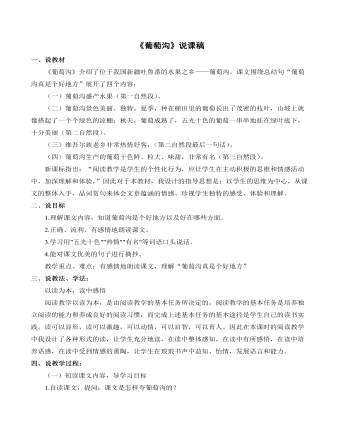
《葡萄沟》说课稿
阅读教学以读为本,是由阅读教学的基本任务所决定的。阅读教学的基本任务是培养独立阅读的能力和养成良好的阅读习惯,而完成上述基本任务的基本途径是学生自己的读书实践。读可以显形,读可以激趣,可以动情,可以启智,可以育人。
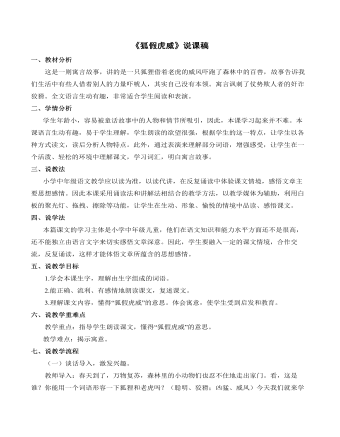
《狐假虎威》说课稿
教师导入:老虎多么凶猛,眼看狐狸就要成为老虎口中的美味佳肴,接下去发生了什么样的事情呢?请大家自己读读2—5自然段。
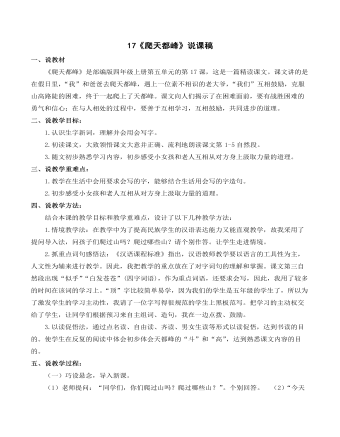
《爬天都峰》说课稿
学生用自己喜欢的方式读课文第二部分,联系上下文理解“奋力、手脚并用、终于”等词语。小组讨论:人物的动作、语言,体验我的心情。
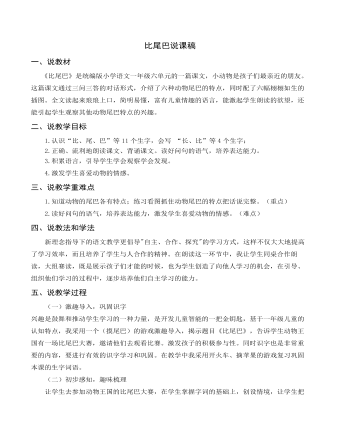
《比尾巴》说课稿
问句朗读是该课时的一个难点。低年级的孩子注意力很容易分散,以趣为主,学生就不容易走神,会积极地投入课文学习中。我设计了当记者的游戏,记者要了解有哪些比赛项目,在了解比赛项目的时候出示第一小节的问句,认识“?”
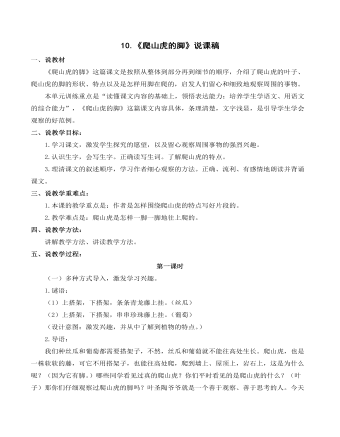
《爬山虎的脚》说课稿
叶圣陶爷爷还观察到了叶子颜色的变化,叶子的颜色是怎么变化的?(嫩红的→嫩绿的→绿得很新鲜)叶子的颜色变化也很美啊,谁能读出这种美来?老师为你们配上音乐和爬山虎的图片,能读得更美吗?

